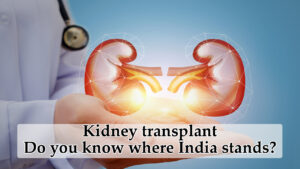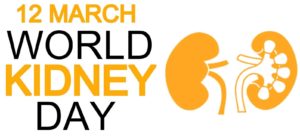Kidney transplant-do you know where India stands? Burden is on the rise and the ministry of health calculation says that the annual requirement for kidneys could range between 2-3 lakh with a mere 6,000 transplants occurring in reality.


Kidney transplant is done when the kidneys lose the ability to filter and thus harmful level of fluid and waste accumulate in your body, which can raise the blood pressure and result in all kinds of symptoms like swelling of body, low hemoglobin, anorexia, Nausea, irritable itching, and easy fatiguability. During the transplant surgery, new kidney is placed in the lower abdomen and connects the artery and vein of the new kidney to new body’s artery and vein. The new kidney starts making urine as soon as the blood starts flowing through it. But sometimes it takes few weeks to start normally.
India’s position at Kidney transplant in the world:
The wait for new and right kidney can be very long sometime in India. Generally the transplanted kidneys comes from the died donors and some come from family members. About 2 lakh patients In India are waiting for organs with mere 15000 donors available. The ministry of health calculation says that the annual requirement for kidneys could range between 2-3 lakh with a mere 6,000 transplants occurring in reality.
The variance between the demand for and supply of kidneys has lead the government to push deceased donor or cadaver donations. The old statistics from the Indian Transplant Registry, a non-governmental initiative by the Indian Society of Organ Transplantation, says that out of the 21,395 kidneys transplanted in India between 1971 and 2015, only 783 were from cadaver or deceased donors.
Also the lack of awareness and hesitation from the family is some of the main reasons for lower cases of deceased donors in India. Well post 2012 there is significant increase in the organ donations. The live kidney transplant programme in India is evolved from the past 50 years and is currently the second largest program in numbers after the USA. The better immunosuppressive drugs and induction agents stop early rejection events and also there has been a various changes regarding using high dose steroids to prevent graft rejection, and this has resulted in lower incidence of postoperative complications after transplant surgery.


The responsibility of making donations happen is with hospitals. So in respect of making it success of this programme, the early identification, certification and maintenance of the potential donors in the the intensive care units is important. To make it more success more public hospitals should participate as mostly victims with severe brain injury due to road traffic accidents finish up in these public hospitals.
The states that has generally relatively better are from south India. In north, Chandigarh has done well in terms of donors as per million population. As of now, the kidney transplant costs between Rs 5 lakh to Rs 6 lakh in private hospitals in the country. And post treatment, the monthly cost is around Rs 15000 and life long medicines Rs 10,000 per month.
The records in Indian Transplant Registry reported that hat between 1971 and 2015, a total of 21,395 kidneys were transplanted in India, out of which a mere number of 783 kidneys belonged to deceased or cadaver donors. It also due to lack of knowledge of the process and apprehension among Indian families, thereby decreasing the number of deceased donors in the country.
The report also says that more than 2.5 lakh people suffer from last-stage kidney diseases every year. In that 7 out of 10 patients go for dialysis and nearly 6 out of those 10 cant continue due to heavy treatment fees. There are dialysis centres but major based in cities. India is the diabetic capital of the world, and increase in the diabetes also leads to proportionate increase in the chronic kidney disease. With the patients suffering from kidney disease and come up at end stage dialysis and kidney transplant is the only option.
Lifestyle modifications to prevent kidney damage:
The theme of World Kidney Day is to raise awareness on the increasing burden of kidney disorders and the ways to prevent it, with an aim to highlight the importance of preventive interventions available. While prevention can be categorized into three phases namely, primary, secondary and tertiary, lifestyle practices play a vital role. Primary 

Post the transplant, one of the major challenges is to sensitize the patient about the importance of the post-post-transplant care and due to any negligence which can be worsen the condition further and can be fatal. Kidney transplants and dialysis are two meaningful replacement therapies available, which can provide good quality of life or longevity to the patients suffering from kidney failure at affordable costs. Never let any kidney patient feel helpless or as if ‘the end of life’ is knocking at the doors.


Dr. Ramesh Jain
HOD – Centre for Kidney Transplant & Renal Sciences
Saroj Super Speciality Hospital, Delhi











